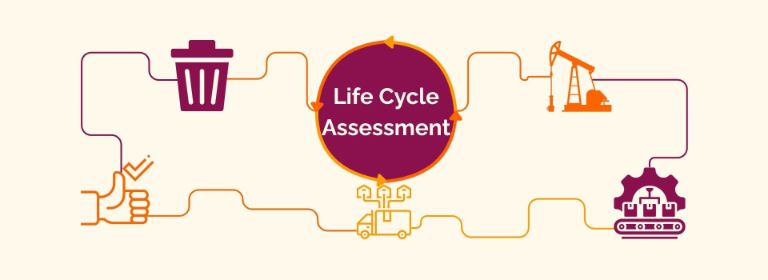Life Cycle Assessment (LCA)

From linearity to circularity
Ready to rethink your product design and boost circularity? With the help of our Life Cycle Assessment (LCA), we work to transform that what companies might think of as waste into regenerative solutions that drive the transition to a circular economy.
Understanding your product life cycle, waste flows, and circularity is crucial to stay ahead of the competition. By embedding circular practices into your operations, you can boost operational efficiency, unlock new revenue opportunities, and ensure compliance with upcoming regulations like the ESPR and PPWR.
Improve the durability of your products, use resources that are easier to recycle, and find ways to reuse your materials, all made possible with our LCA.
Curious to know more? This is how we do it:
- Step 1: Scope definition
- Step 2: Data collection
- Step 3: Hotspot analysis
- Step 4: Circular plan
-
Define the scope and goal of the LCA
The first step in an LCA is to clearly define the scope. We begin by identifying the functional unit (e.g. product, batch, location, company) that serves as the reference point for our analysis. Next, we determine the extent and goal of the LCA: will we stop at the gate or cover the entire life cycle, moving from cradle-to-grave to cradle-to-cradle? Finally, we select relevant impact categories and emission factors for the data collection and analysis, as well as the calculation the environmental footprint.
-
Collect data across the life cycle
Data collection involves gathering detailed information across the stages of the life cycle. This includes gathering input data such as the types and amounts of materials used, the kind and amount of energy consumed, and water usage. It also covers data on activities like manufacturing processes and transportation logistics. Additionally, outputs must be recorded as well, including greenhouse gas emissions, pollution, and waste generation. This comprehensive dataset forms the foundation for the hotspot analysis.
-
Analyse the data and identify hotspots for circularity
Once data is collected, we start with the data analysis to calculate the product’s environmental footprint. This involves assessing the impacts across different life cycle stages and identifying hotspots that are most resource-intensive, polluting or wasteful. These hotspots represent key opportunities for reducing your environmental impact and improving the overall sustainability of the products and processes.
-
Develop a plan of action to transition from linearity to circularity
The final step is to turn insights into action. This includes developing strategies to enhance circularity, such as optimizing design for durability, reusability or recyclability. Recommendations for the next steps are also presented, such as the creation of a Digital Product Passport (DPP) to support transparency and traceability across the supply chain. Finally, further advice is provided on how to align the LCA with the requirements of the upcoming Ecodesign for Sustainable Products Regulation (ESPR) and Packaging and Packaging Waste Regulation (PPWR), ensuring regulatory compliance and market readiness.
The potential of an LCA
Material insights
An LCA provides valuable insights into products and activities. By utilizing these insights, companies can improve operational efficiency, extend product lifespans, use more recycled or renewable materials, design for reuse and repair, and drive sustainable growth.
Regulatory compliance
Adopting a circular mindset enables companies to stay ahead of evolving regulations. With new EU policies like the ESPR and PPWR, circular strategies are increasingly becoming necessary to meet regulatory requirements and prepare for the future.
Innovative designs
Circularity drives smarter design, leaner operations, and long-term business resilience. By applying circular principles across your operations, from product design to supply chains, you foster innovation, reduce waste, and improve efficiency.
Want to know more about circularity?
Circularity is more than a green choice, it’s the path to greater independence, less waste, and a more resilient business.
Why is a Life Cycle Assessment important for your business?
An LCA can help uncover opportunities for material efficiency gains, as well as reductions in costs and waste. Through smarter product designs and more effficient operations, circularity can make your business more resilient and future-proof. Additionally, it can help you prepare for the upcoming ESPR and PPWR, and strengthen your long-term brand reputation.
Which companies should conduct a Life Cycle Assessment?
An LCA is essential for manufacturers, product designers, and companies with complex material flows or high environmental impacts. Construction and packaging companies use it to optimise recycled content and end-of-life strategies, while other B2B suppliers benefit stakeholders by providing verified data. Sectors such as electronics, textiles, and furniture will soon require to conduct an assessment and create a Digital Product Passport for ESPR compliance.
When should you start conducting a Life Cycle Assessment?
Beginning your LCA early during product development stages can have the most impact on your costs, efficiency and sustainability. Early action enables smarter material choices, smarter product designs, and alignment with customer needs. Annual updates can help track progress, further drive continuous improvement, and prepare you for upcoming ESPR and PPWR deadlines.
How can a Life Cycle Assessment help you stay innovative and compliant?
An LCA provides the verified environmental data needed to create a DPP for ESPR compliance. It's a useful method to identify ways to improve durability, recyclability, and efficiency. Insights support innovative business models like product-as-a-service or take-back schemes. Hotspot analyses help identify important impact sources, so you can implement concrete improvements and unlock market opportunities.
What makes our Life Cycle Assessment and SaaS model unique?
Our Sustainability as a Service model keeps your life cycle assessment accurate, relevant, and compliant over time. We update the assessments when suppliers, materials, or ESPR requirements change, maintain Digital Product Passports, and track circularity metrics. By supporting you continuously, we ensure your LCA remains a strategic asset for innovation and sustainable business development.